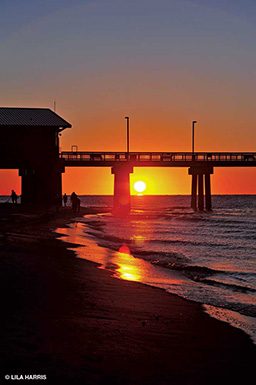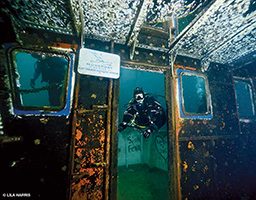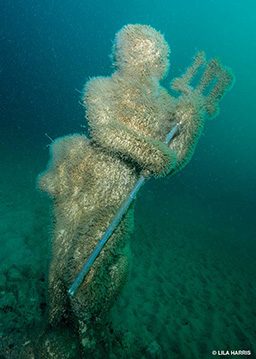After driving over one of the three bridges to the gulf coast of Alabama, you’ll find yourself on the beautiful white sandy shore of Orange Beach or Gulf Shores. You might be welcomed to this laid-back world of Southern hospitality with a glass of sweet tea, which you can sip while looking out over the Gulf of Mexico. The allure of Alabama’s coastline is evident, but you may wonder whether there is any decent diving to be had. Not only is there fantastic diving off the beaches of Alabama, but the state also boasts one of the largest artificial reef programs in the United States.
The artificial reef program in Alabama began in 1953 when the Orange Beach Charter Boat Association sank 250 car bodies. Over the next several decades Alabama continued to put more steel reef on its flat, sandy bottom, including five Liberty ships in 1974. In 1987 the U.S. Army Corps of Engineers issued a permit to establish almost 800 square miles of artificial reef area, which was expanded to approximately 1,260 square miles in 1997. As a result, Alabama’s coastline includes about 17,000 artificial reef sites, putting Alabama on the map for fishing, scuba diving, freediving and spearfishing enthusiasts.

Liberty Ships
Diving one of Alabama’s five Liberty ships can elicit a sense of awe based on the size alone. Each of these magnificent naval cargo ships from World War II is more than 400 feet long and 75-80 feet wide. As you descend through schools of spadefish at 80-100 feet, you can catch glimpses of manta rays, turtles, amberjack, tuna and angelfish as they, too, explore the historic vessels. Both the Wallace and the Allen offer wide swim-throughs where you can spy smaller sea life such as octopuses, toadfish, blennies and even the occasional frogfish. The architecture of these ships, which are located between 8 and 20 nautical miles offshore from Orange Beach’s Perdido Pass, offers atmospheric backdrops for underwater photographers.
Bridge Rubble
Although they may lack an appealing designation, the bridge rubble sites will pleasantly surprise you. With names like “Rome” and “Atlantis,” these sites are reminiscent of archways and fallen pillars, evoking the experience of exploring ancient ruins. The bridge rubble sites, created primarily from the old Perdido Pass Bridge, offer the possibility of finding shovel-nose lobsters, flounder and southern stingrays as well as gamefish such as amberjack, red snapper and triggerfish. Bridge rubble dives are favorites among Alabama freedivers and spearfishers.
Tanks
In 1993 the U.S. military and the Marine Resources Division of the Alabama Department of Conservation and Natural Resources joined to create the Reef-Ex program to demilitarize 100 obsolete M-60 tanks. Once used in military operations, these tanks were cleaned of hazardous materials and can now be found in depths of 70-110 feet. On a recent dive to the tanks, I saw lionfish, gobies, a huge goliath grouper and two seahorses on a single tank.
The LuLu

As soon as you enter the water above it, you will fall in love with the LuLu. This 271-foot retired coastal freighter is the crown jewel of Alabama diving. Sinking the LuLu was the first undertaking of the Alabama Gulf Coast Reef and Restoration Foundation (AGCRRF), a nonprofit created in 2012 to support artificial reef development in Alabama’s coastal waters and throughout the northern Gulf of Mexico. On May 26, 2013, surrounded by more than 200 boats, the LuLu descended in a perfect upright position to a depth of about 115 feet. The wheelhouse, at 60 feet, features ladders, hallways and plentiful windows and doors ripe for exploration. It’s a wreck diver’s dream.
The LuLu was a local favorite from the beginning. With tremendous local and state support, the ship received its name from primary sponsor Mac McAleer, who named it after Lucy Buffett, local restauranteur and Jimmy’s sister. From day one after her sinking, the LuLu has been an incredible habitat for snapper, amberjack, tuna, grouper and many tropical fishes. It is located 17 nautical miles south of Perdido Pass in Orange Beach

Poseidon’s Playground
Sitting in 35-40 feet of water 3.5 miles off Perdido Pass, Poseidon’s Playground is AGCRRF’s newest project, created to offer more shallow-water diving opportunities for novice and young divers and for diver training. This ever-evolving project promises to be a virtual underwater amusement park, with whimsical structures that will potentially include a see-saw, a bar with bar stools and many other fun photo ops for divers. The initial deployment in December 2014 included statues of Poseidon, Venus and Apollo along with a “grouper reef” of concrete seahorses, dolphins and triggerfish. This spring the group added a wedding platform to the site. Along with AGCRRF, local sponsors and artists are creating more unique structures, with the goal of having at least 40 pieces by the summer of 2018. This site is designated as a no-anchor zone to protect the structures, but the AGCRRF has deployed several moorings.
Ancient Cypress Forest
A fascinating hidden gem lies about 10 miles off the Alabama coast. After Hurricane Katrina, a diver discovered an ancient cypress forest containing trees that have been dated to approximately 50,000 years ago. The Weeks Bay Foundation is currently working to create a marine protected area to preserve these ancient organisms; therefore, the location of the forest is not being revealed. The foundation hopes to eventually create a protected area where fishing and scuba diving are allowed.
Beach Dives
There are a few beach dives in Alabama and more planned for the future. Alabama Point, just south of the Perdido Pass Bridge in Orange Beach, is the best choice at this time. You can dive under the bridge, but you will need to plan around the high tides. The Whiskey Wreck, an old rumrunner, is approximately 200 yards off of Gulf Shores in less than 20 feet of water. To dive it, wait until a calm day for clear visibility.
How To Dive It
Conditions
Alabama offers a nice mix of warm and cool conditions. Air temperatures can range from occasional high 20s (°F) in the winter to low 100s in the summer. The water temperature in the winter can drop to 60°F, slowly warming up in the spring to 68-72°F, while summer water temperatures reach 79-80°F by July or August. Fall temperatures drop slowly, so diving in late November is still quite comfortable.
Water visibility varies day to day, from 100 feet to less than 15 feet. The further offshore you go, the better the visibility.
Most sites are between 3 and 25 miles offshore. Since the Alabama Gulf is mostly a flat, sandy environment, dive charters are the best way to dive. Due to plentiful plankton, anglers can enjoy fishing in back bays and deep offshore locations. Divers have been known to see spotted morays, balloonfish, butterflyfish, sheepshead and even manatees or an occasional whale shark. Gamefish found offshore include cobia, wahoo, bonito, marlin, king mackerel and more.
Getting There
The nearest airports are Pensacola International (30 miles away) and Mobile Regional (70 miles away).
On the Surface
The Alabama Gulf Coast offers topside adventures such as ziplining, backwater kayaking and hiking. Visitors should check out the Alabama Gulf Coast Zoo, known as the “little zoo that could” due to its commitment to evacuate and rehabilitate animals after several hurricanes.
There are countless festivals and art shows, especially during the warmer months. Don’t miss the annual Interstate Mullet Toss at the Flora-Bama in April or the Hangout Music Festival in May.
There are great local “dives” with colorful atmosphere and great music as well as fine dining. One of the best parts of boating in Alabama is cruising to your favorite restaurant and watching the glorious sunset on your way back.
© Alert Diver — Q3 Summer 2015